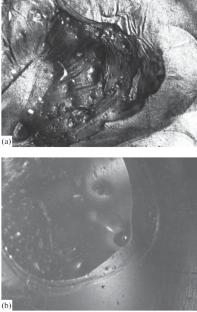溶液形成过程中磁场对聚乙烯醇膜结构的影响
IF 0.3
Q4 MATERIALS SCIENCE, MULTIDISCIPLINARY
引用次数: 0
摘要
采用差示扫描量热法(DSC)和拉曼散射(RS)分析了水溶液在磁场作用下在玻璃和铝基底上形成聚乙烯醇薄膜的结构特征。结果表明,在磁场中形成薄膜时,聚乙烯醇的结晶度增加,大分子的立体异构性发生变化。与在磁场外制备的样品相比,在磁场中形成的薄膜具有更高的电阻。本文章由计算机程序翻译,如有差异,请以英文原文为准。

Influence of Magnetic Field on Structure of Polyvinyl Alcohol Film during Formation from Solution
The methods of differential scanning calorimetry (DSC) and Raman scattering (RS) were used to analyze the structural features of polyvinyl alcohol (PVA) films formed in a magnetic field from an aqueous solution on glass and aluminum substrates. It was determined that, when films are formed in a magnetic field, the degree of crystallinity of PVA increases and the stereoisomerism of macromolecules changes. Films formed in a magnetic field have higher electrical resistance compared to samples prepared outside the field.
求助全文
通过发布文献求助,成功后即可免费获取论文全文。
去求助
来源期刊

Inorganic Materials: Applied Research
Engineering-Engineering (all)
CiteScore
0.90
自引率
0.00%
发文量
199
期刊介绍:
Inorganic Materials: Applied Research contains translations of research articles devoted to applied aspects of inorganic materials. Best articles are selected from four Russian periodicals: Materialovedenie, Perspektivnye Materialy, Fizika i Khimiya Obrabotki Materialov, and Voprosy Materialovedeniya and translated into English. The journal reports recent achievements in materials science: physical and chemical bases of materials science; effects of synergism in composite materials; computer simulations; creation of new materials (including carbon-based materials and ceramics, semiconductors, superconductors, composite materials, polymers, materials for nuclear engineering, materials for aircraft and space engineering, materials for quantum electronics, materials for electronics and optoelectronics, materials for nuclear and thermonuclear power engineering, radiation-hardened materials, materials for use in medicine, etc.); analytical techniques; structure–property relationships; nanostructures and nanotechnologies; advanced technologies; use of hydrogen in structural materials; and economic and environmental issues. The journal also considers engineering issues of materials processing with plasma, high-gradient crystallization, laser technology, and ultrasonic technology. Currently the journal does not accept direct submissions, but submissions to one of the source journals is possible.
 求助内容:
求助内容: 应助结果提醒方式:
应助结果提醒方式:


